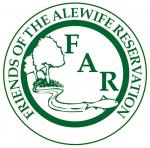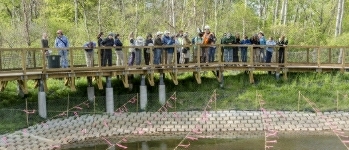Posted Feb. 22, 2014 @ 3:51 pm
ARLINGTON
On this snowy afternoon the title of "early spring" may seem wishful thinking to others. Yet there are changes in nature with ice and snow that give clear signs, demonstrating the natural underbelly of soon-to-come green growth and the breeding season at Alewife Reservation, here in New England at one of the busiest transportation arteries in the Boston area.
Just a couple of days ago I saw dried leaves and underbrush near the creek or channel, historically, "Alewife Brook," which runs beside and into Little River from North Cambridge. I thought how colorless and cold it looked in spite of shining blue skies, and it was only 20 degrees.
But yes, there was a hint of spring in the frigid air and I took my clues from the birds. A patch of red on the breast of a small bird suddenly came into view. We met eye-to-eye for a moment until the lively thing hopped off to join a friend in tearing through some dead branches. Hard to believe I saw two returning robins, perhaps trying to stake out a territory in order to build a future nest in the frozen urban wild, with cars whizzing by.
There are wintering robins, but these seemed new here because of their frantic search for food. Wintering robins know where their food source is and stay there. In February and March, the common and welcomed robin is migrating back to northern climates to look for fruit not available elsewhere, and to begin choosing a mate and locating a future nesting spot. What seems to attract early migrants is the sumac tree, prolific at Alewife which bears a large fuzzy reddish fruit cluster of "drupes" called "bobs", which so many of us see as a 'weed' tree, but is actually a survival source at Alewife for many wintering mammals and birds. Robins are worm-hungry as well, which are not now available.
A large number of waterbirds congregated at Little River bridge behind the T station which is the T side entry into the Reservation, and the new storm water/wetland. Every breed that swims, hunts or lingers had gathered that day: young and mature geese, mallards and hybrid ducks, and two male hooded mergansers.
Even my favored long and lanky great blue heron of Yates Pond flew in to join the get-together. We counted 50-plus birds hanging out, and we joined the comraderie. Despite the harshness of winter, the group of diverse friends seemed proud and fit, though still puffed up to prevent cold penetration. We saw no disputes, but a couple of young geese seemed to be making strong statements to their counterparts. I've seen these gatherings and they often last several hours, similar to a community meeting in the human world.
On this day, as the robin's plummage had forcasted, I suspect their gathering was to keep warm in that river spot with extra nutrients, which is also a discharge location for the Mass Water Resources Authority (MWRA), and to celebrate the beginning of spring for the Reservation's inhabitants.
A robin caught eating some sumac at Alewife Reservation recently. Courtesy Kathy Johnson

Pubilshed in Wicked Local Arlington. Accessed 2014-03-02.
http://arlington.wickedlocal.com/article/20140222/NEWS/140228716?refresh=true
- Home
- Directions
- FAR Wildlife Blog
- Calendar
- News
- Donate Now
- Get Social!
- Storm Water Wetlands
- Plants and Restoration
- Photos
- Videos
- About & Projects
- Master Plan for Alewife
- Archive
- Newsletters
- Contact
 Presentation Spotlighting Alewife Reservation
Presentation Spotlighting Alewife Reservation
 Follow us on Twitter
Follow us on Twitter
 Like us on Facebook
Like us on Facebook
 Follow us on Instagram
Follow us on Instagram
Forward our web address to a friend!
- An Urban Gem - Alewife Reservation Nature Preserve
- Envisioning The Silver Maple Forest
- History and Policies of Cambridge, Belmont, and DEP
- Storm Water Wetlands
- Friends of Alewife Reservation brochure
(front, back) - Technical Analysis of Upper Alewife Basin
- Watershed: An Excursion in Four Parts
- The River Is A Restless Spirit: Life in the floodplain forest
-
Assessment of Silver Maple forest for DEP Adjudicatory hearings and
Patrick Fairbairn, author of the Assessment - Community Native Garden Flora
The
Alewife Reservation
is a unique natural resource for the communities of Belmont, Arlington and Cambridge
and home to hundreds of species, including hawks, coyotes beavers, snapping turtles, wild turkeys and muskrats,
the reservation is a unique natural resource for the community.
Historical information (Powerpoint)
Friends of Alewife Reservation works to protect and restore this wild area and the surrounding area for the water quality, native plants, animals and over 90 bird species with paths for walking, running and biking, recreation, and for classroom education and research. We regularly steward and preserve the Reservation area for wildlife and for the enjoyment of present and future generations.

(video)
By-Laws
About Friends of Alewife Reservation
Statement of Purpose
Citizen Forester newsletter archive
The Birds of the Cambridge Region of Massachusetts

by William Brewster 1906
Nuttal Ornithological Society
Biodiversity Study of Alewife Reservation Area: Species, Habitat, Ecosystems

Inventories by David Brown, wildlife assessor (2003, 2004.) Published by and available from FAR for $10. Write or call for your copy. (sample)
Updated Dave Brown Inventories (2008, 2010)
Inventories of Alewife Reservation Wetland Plants by Walter Kittredge, Botanist (2013)

